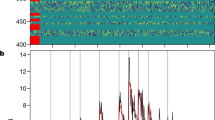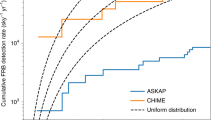Abstract
The Rapid Burster is a unique X-ray source which produces rapidly repetitive X-ray bursts. Each rapid burst shows a characteristic structure in its decay part comprising successive peaks. We have now discovered that the structure of each individual burst shows a nearly identical profile except for the timescale, which differs largely from burst to burst; the profile of the decay is timescale invariant. This invariance holds over a wide range of timescales to at least a factor of 30. Furthermore, we have found that the heights of successive peaks as well as the intervals between them decrease with time according to a common arithmetic rule.
This is a preview of subscription content, access via your institution
Access options
Subscribe to this journal
Receive 51 print issues and online access
$199.00 per year
only $3.90 per issue
Buy this article
- Purchase on Springer Link
- Instant access to full article PDF
Prices may be subject to local taxes which are calculated during checkout
Similar content being viewed by others
References
Lewin, W. H. G. et al. Astrophys. J. Lett. 207, L95–L99 (1976).
Hoffman, J. A., Marshall, H. L. & Lewin, W. H. G. Nature 271, 630–633 (1978).
Kunieda, H. et al. Publ. astr. soc. Jap. 36, 807–817 (1984).
Author information
Authors and Affiliations
Rights and permissions
About this article
Cite this article
Tawara, Y., Kawai, N., Tanaka, Y. et al. Timescale-invariant profile of the type II bursts from the Rapid Burster. Nature 318, 545–547 (1985). https://doi.org/10.1038/318545a0
Received:
Accepted:
Published:
Issue Date:
DOI: https://doi.org/10.1038/318545a0
This article is cited by
-
A theory for gamma ray and X-ray burst sources
Astrophysics and Space Science (1995)
Comments
By submitting a comment you agree to abide by our Terms and Community Guidelines. If you find something abusive or that does not comply with our terms or guidelines please flag it as inappropriate.



